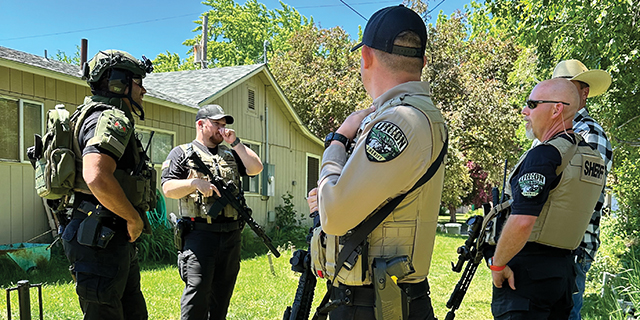Thinking out loud: We could benefit from nighttime lighting restrictions
Published 6:00 am Thursday, May 4, 2023

- Morrison
This spring, my husband and I traveled to visit family we hadn’t seen since the pandemic began.
I’ve visited Phoenix many times.
It always amazes me as a vast, sprawling metropolis, filling an entire desert basin which fundamentally lacks the capacity to sustain a fraction of the ever-growing number of people who live there.
The freeways are wide and fast and often at a standstill; the development so endless that it’s impossible even to get a sense of the underlying geography.
Each time I visit, the word “folly” comes to mind: a construction so exceedingly extravagant that it connotes lunacy or madness.
I think also of the poem “Ozymandias,” about the Egyptian pharaoh who constructed a massive sculpture to proclaim his power and magnificence, but centuries later: Nothing beside remains. Round the decay / Of that colossal Wreck, boundless and bare / The lone and level sands stretch far away.
We stopped briefly at the Maricopa-Salt River Pima reservation, the only place I know of in the Phoenix area still open enough to see the purple mountains that surround the basin, or the land that once was, and as “Ozymandias” suggests, someday will be again.
After Phoenix, we visited friends who live south of Tucson, and doing so provided one of the unexpected insights that travel often brings.
Our friends commented that they live in a “dark sky” county: Pima County has enacted ordinances to preserve nighttime darkness for the benefit of local observatories.
The ordinances require all outdoor lights, including commercial signs and residential lighting, to shine downward and to be shielded from above.
It prohibits certain kinds of lighting such as mercury vapor lights, requires streetlights to be dimmed from midnight to dawn, and imposes a curfew requiring outdoor lighting to be turned off during designated hours. I couldn’t imagine what a town with such restrictions would look like.
So our friends took us outside that night to see the local streets and look across the breadth of the town. And it was amazing.
It wasn’t so dark as to make walking or driving dangerous. The low lights of nearby residences provided plenty of light to allow pedestrians or drivers to see their way.
Below us, the town emanated a soft golden glow, and above, a million stars danced in the desert’s nighttime sky.
Municipalities in Pima County discuss their lighting restrictions in terms of the benefits to nocturnal wildlife including migrating birds, the conservation of energy and the millions of tax dollars saved.
Of course, learning about the lighting restrictions made me wonder about the way our own community regulates the use of light, and why La Grande couldn’t achieve similar benefits by enacting similar ordinances.
Learning about Pima County’s ordinances revived other questions I’ve always wondered about. Why do we have streetlights, for example?
Our house in La Grande sits on a
corner lot. Like nearly every corner
in La Grande, it has a streetlight that glares halfway down the block in four different directions from dusk to
dawn.
Despite the fact that residential lights have made it easy to see your way, on foot or by car when the streetlight is out, it still lights up every night when darkness falls.
It makes me wonder about the cumulative amount of energy La Grande’s streetlights consume, what purpose they really serve if it’s easy enough to see without them, about the amount of physical resources required to construct and transmit energy for streetlights, and about the amount of money our city spends for lights that may not even be needed in the first place.
Do we have them merely because streetlights were once considered a
symbol of modernization and development?
Or because early utility companies pushed so hard to facilitate any use
of electricity to generate revenue to
cover the costs of building our region’s dams?
And when did we all — car dealers and gas station owners and restaurant managers and homeowners — become so obsessed with lighting up the night, without considering the costs of unnecessary of energy use?
In any case, our community is blessed with local leaders who are confident they have the knowledge and experience to identify local issues and the leadership skills to move our community forward in positive directions.
Maybe they will consider our community’s unnecessary use of energy, the waste of resources and tax dollars it represents, the fact that no community is too small to do its part to avert climate catastrophe, and the fact that our own city’s actions can provide positive examples for communities and individuals alike.
If they can do it in Tucson, we can do it here.
Perhaps dialing down our use of nighttime light would even restore
our ability to marvel at what many people view as God’s creation, described so poetically by Louis Armstrong: “the bright blessed day … the dark sacred night.”
Below us, the town emanated a soft golden glow, and above, a million stars danced in the desert’s nighttime sky. Municipalities in Pima County discuss their lighting restrictions in terms of the benefits to nocturnal wildlife including migrating birds, the conservation of energy and the millions of tax dollars saved.




